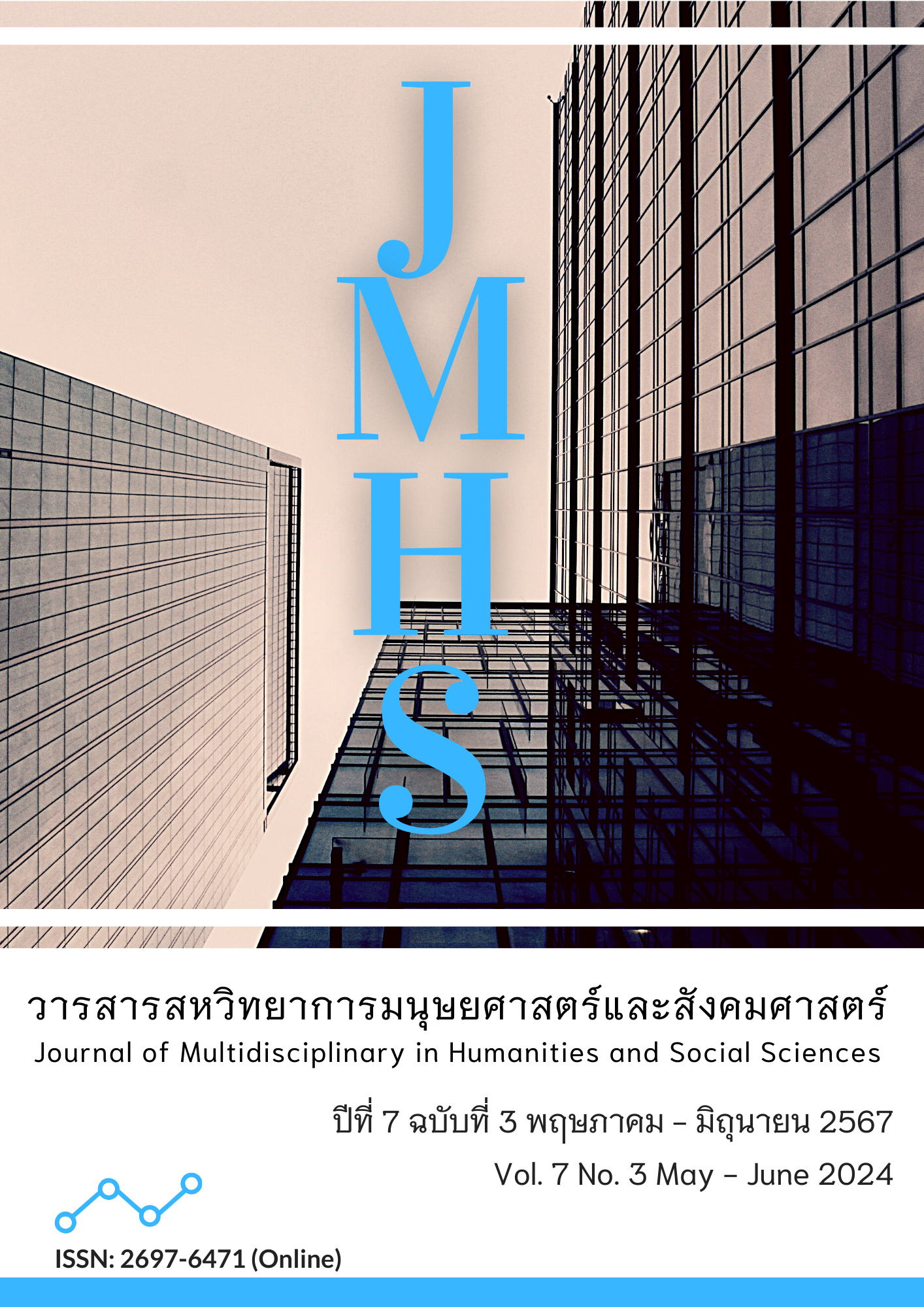Model of True Leadership Based on Gharavasadhamma for School Administrators under Office of Primary Educational Service Area
Main Article Content
Abstract
This article aimed to: 1) study the actual leadership needs of educational institution administrators under the jurisdiction of the Primary Educational Service Area Office; 2) develop a true leadership model based on the principles of Gharavasadhamma for educational institution administrators under the Office of the Primary Educational Service Area; and 3) assess the true leadership style according to the principles of Gharavasadhamma for educational institution administrators under the jurisdiction of the Primary Educational Service Area Office. It was a combined method of research. There were three research steps: Step 1: To study the actual leadership needs of educational institution administrators by using a questionnaire on a sample of 368 teachers, the data were analyzed using basic statistics, namely, percentage, mean, standard deviation, and the index of essential needs (PNIModified). Step 2: To develop a model by interviewing 10 key informants and organizing group discussions with 9 experts. Research tools included an interview form and question guidelines for group discussions. The data were analyzed using content analysis. And step 3: To evaluate the model using an evaluation form for a sample of 310 educational institution administrators, the data were analyzed using basic statistics, namely, percentage, mean, and standard deviation.
It was found that: 1. The need for true leadership of educational institution administrators under the jurisdiction of the Primary Educational Service Area Office overall with an index of essential needs was between 0.035-0.052. The component with the highest need was a balanced process, followed by self-awareness, justice, transparency, and a positive outlook, respectively. 2. For educational institution administrators under the jurisdiction of the Primary Educational Service Area Office, the true leadership style, as defined by the principles of Gharavasadhamma, consists of five elements. And 3. Evaluation of the assessment of true leadership styles according to the principles of Gharavasadhamma for educational institution administrators under the jurisdiction of the Primary Educational Service Area Office overall. The evaluation results were at the highest level in all 4 areas, ordered from highest to lowest, namely: usefulness, correctness, possibility, and suitability.
In summary, the research knowledge is concluded into PANPET, referring to P (process), A (application), N (need), P (principles of Gharavasadhamma), E (educational administration), and T (true leadership).
Article Details

This work is licensed under a Creative Commons Attribution-NonCommercial-NoDerivatives 4.0 International License.
Views and opinions appearing in the Journal it is the responsibility of the author of the article, and does not constitute the view and responsibility of the editorial team.
References
กฤติมา มะโนพรม, สันติ บูรณะชาติ, โสภา อำนวยรัตน์ และ น้ำฝน กันมา. (2563). รูปแบบการพัฒนาภาวะผู้นำที่แท้จริงของผู้บริหารสถานศึกษาขั้นพื้นฐาน. วารสารศึกษาศาสตร์มหาวิทยาลัยบูรพา, 31(1), 152-168. สืบค้นจาก https://so02.tci-thaijo.org/index.php/edubuu/article/view/244184
เกรียงไกร นามทองใบ และ ธรินธร นามวรรณ. (2564). การพัฒนาโปรแกรมเสริมสร้างภาวะผู้นำเชิงสร้างสรรค์ของผู้บริหารสถานศึกษาสังกัดสำนักงานเขตพื้นที่การศึกษาประถมศึกษาศรีสะเกษ เขต 3. วารสารมหาวิทยาลัยราชภัฏมหาสารคาม, 15(1), 159-171. สืบค้นจาก https://so05.tci-thaijo.org/index.php/rmuj/article/view/250844
บุญชม ศรีสะอาด. (2535). การวิจัยเบื้องต้น. (พิมพ์ครั้งที่ 5). กรุงเทพฯ: สุวีริยาสาส์นการพิมพ์.
พระครูปลัดณัฐวัฒน์ อนุหนายนน์, สุทธิพงษ์ ศรีวิชัย และ พระมหาสมบัติ ธนปญฺโญ. (2563). รูปแบบภาวะผู้นำของผู้บริหารตามหลักฆราวาสธรรม 4 โรงเรียนประถมศึกษาสังกัดกรุงเทพมหานคร. วารสารครุศาสตร์ปริทรรศน์ คณะครุศาสตร์ มหาวิทยาลัยมหาจุฬาลงกรณราชวิทยาลัย, 7(3), 231-241. สืบค้นจาก https://so02.tci-thaijo.org/index.php/EDMCU/article/view/245938
พระธรรมกิตติวงศ์ (ทองดี สุรเตโช). (2551). พจนานุกรมเพื่อการศึกษาพุทธศาสตร์ คำวัด. (พิมพ์ครั้งที่ 3). กรุงเทพฯ: ธรรมสภาและสถาบันบันลือธรรม.
พระธรรมปิฎก (ป. อ. ปยุตฺโต). (2543). พจนานุกรมพุทธศาสตร์ ฉบับประมวลธรรม. (พิมพ์ครั้งที่ 9). กรุงเทพฯ: มหาจุฬาลงกรณราชวิทยาลัย.
พระศรีคัมภีรญาณ (สมจินต์ วันจันทร์). (2559). บูรณาการพุทธธรรมเพื่อเสริมสร้างพลังบริหาร. (พิมพ์ครั้งที่ 2). กรุงเทพฯ: มหาจุฬาลงกรณราชวิทยาลัย.
พิพัฒน์ นนทนาธรณ์. (2558). ภาวะผู้นำเชิงปฏิบัติการ. กรุงเทพฯ: มหาวิทยาลัยเกษตรศาสตร์.
มหาจุฬาลงกรณราชวิทยาลัย. (2539). พระไตรปิฎกภาษาไทยฉบับมหาจุฬาลงกรณราชวิทยาลัย. กรุงเทพฯ: มหาจุฬาลงกรณราชวิทยาลัย.
วิโรจน์ สารรัตนะ. (2557). ภาวะผู้นำ: ทฤษฎีและนานาทักษะร่วมสมัยปัจจุบัน. กรุงเทพฯ: ทิพยวิสุทย์.
สำนักงานคณะกรรมการการศึกษาขั้นพื้นฐาน. (2565, 25 กันยายน). ข้อมูลสถานศึกษา. สืบค้นจาก https://www.obec.go.th/เว็บไซต์-สพป-ในสังกัด.
สำนักงานคณะกรรมการการศึกษาชั้นพื้นฐาน กระทรวงศึกษาธิการ. (2552). คู่มือการปฏิบัติงานข้าราชการครู. กรุงเทพฯ: กระทรวงศึกษาธิการ.
สำนักงานเลขาธิการสภาการศึกษา กระทรวงศึกษาธิการ. (2560). แผนการศึกษาแห่งชาติ พ.ศ. 2560-2579. กรุงเทพฯ: พริกหวานกราฟฟิค.
สุวิมล ว่องวาณิช. (2558). การวิจัยประเมินความต้องการจำเป็น. (พิมพ์ครั้งที่ 3). กรุงเทพฯ: จุฬาลงกรณ์มหาวิทยาลัย.
Avolio, B. J., & Luthans, F. (2003). Authentic Leadership Development. In Cameron, K.S., Dutton, J.E. and Quinn, R.E. (Eds.). Positive Organizational Scholarship: Foundations of a New Discipline. San Francisco: Berrett-Koehler.
Avolio, B., & Gardner, W. L. (2005). Authentic Leadership Development: Getting to the Root of Positive Forms of Leadership. The Leadership Quarterly, 16, 315-338. https://doi.org/10.1016/j.leaqua.2005.03.001
Cronbach, L. J. (1971). Essentials of Psychological Testing. (4th ed.). New York: Harper & Row.
Damnoen, P. S., Siri, P., Supattho, P. S., & Kaewwilai, K. (2021). The Development of Student Characteristics in According to the Nawaluk Framework of the Buddhist integration of Buddhapanya Sri Thawarawadee Buddhist College. Asia Pacific Journal of Religions and Cultures, 5(2), 126-135. Retrieved from https://so06.tci-thaijo.org/index.php/ajrc/article/view/249662
Gardner, W. L, Cogliser, C. C., Davis, K. M., & Dickens, M. P. (2011). Authentic Leadership: A Review of the Literature and Research Agenda. The Leadership Quarterly, 22(6), 1120-1145. https://doi.org/10.1016/j.leaqua.2011.09.007
Gardner, W. L., Avolio, B. J., Luthans, F., May, D. R., & Walumbwa, F. (2005). “Can You See the Real?” Me A Self-Based Model of Authentic Leader and Follower Development. The Leadership Quarterly, 16(3), 343-372. https://doi.org/10.1016/j.leaqua.2005.03.003
George, B. (2003). Authentic Leadership: Rediscovering the Secrets to Creating Lasting Value. San Franciso: Jossey-Bass.
Krejcie, R. V. & Morgan, D. W. (1970). Determining Sample Size for Research Activities. Educational and Psychological Measurement, 30(3), 607-610. https://doi.org/10.1177/001316447 003 0003
Likert, R. (1967). The Method of Constructing and Attitude Scale. In Reading in Attitude Theory and Measurement. Fishbeic, Matin. (Eds.). New York: Wiley & Son.
Sinclair, A. (2010). Placing Self: How Might We Place Ourselves in Leadership Studies Differently. Leadership, 6(4) 447-460. https://doi.org/10.1177/1742715010379312
Walumbwa, F. O., Avolio, B. J., Gardner, W. L., Wernsing, T. S., & Peterson, S. J. (2008). Authentic Leadership: Development and Validation of a Theory-Based Measure. Journal of Management, 34(1), 89-126. https://doi.org/10.1177/0149206307308913


